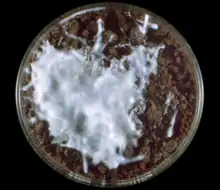Trichophyton mentagrophytes
Trichophyton mentagrophytes is a species in the fungal genus Trichophyton.[1] It is one of three common fungi which cause ringworm in companion animals. It is also the second-most commonly isolated fungus causing tinea infections in humans, and the most common or one of the most common fungi that cause zoonotic skin disease (i.e., transmission of mycotic skin disease from species to species). Trichophyton mentagrophytes is being frequently isolated from dogs, cats, rabbits, guinea pigs and other rodents,[2][3][4] though at least some genetic variants possess the potential of human-to-human transmission, e.g. Type VII[5] and Type VIII.[6] Particular genetic variants of the fungus have distinct geographic ranges.[7]
| Trichophyton mentagrophytes | |
|---|---|
| Scientific classification | |
| Kingdom: | |
| Division: | |
| Class: | |
| Order: | |
| Family: | |
| Genus: | |
| Species: | T. mentagrophytes |
| Binomial name | |
| Trichophyton mentagrophytes (Robin) Blanchard (1853) | |

Drug resistance
In T. mentagrophytes, antifungal drug resistance is mainly associated with Type VIII isolates. Drug-resistant T. mentagrophytes strains have been found in many places across Asia and Europe. India is the most affected country, with the rate of microbiological resistance to terbinafine estimated at 11.4%.[8] There are also reports on terbinafine-resistant Type II isolates from Japan and Denmark.
Molecular strain typing
For studies on the epidemiology of T. mentagrophytes, two molecular strain typing techniques are available. The first one is based upon amplification of nontranscribed spacer of ribosomal DNA,[9] and the second one involves a comparison of internal transcribed spacer sequences within defined boundaries.[7]
Nomenclature
Along with closely related T. interdigitale, the species has been traditionally treated as a part of polyphyletic morphological assemblage, named "T. mentagrophytes sensu lato".[10][11] From 1999 to 2017 the two species have been collectively referred to as T. interdigitale, while the name "T. mentagrophytes" has been used for current T. quinckeanum.[1][12][13] Trichophyton interdigitale seems to be strictly anthropophilic,[14][11] and is associated with foot and nail infections.[7]
References
- de Hoog GS, Dukik K, Monod M, et al. (2017). "Toward a novel multilocus phylogenetic taxonomy for the dermatophytes". Mycopathologia. 182 (1–2): 5–31. doi:10.1007/s11046-016-0073-9. PMID 27783317.
- Cafarchia C, Weigl S, Figueredo LA, Otranto D (2012). "Molecular identification and phylogenesis of dermatophytes isolated from rabbit farms and rabbit farm workers". Veterinary Microbiology. 154 (3–4): 395–402. doi:10.1016/j.vetmic.2011.07.021. PMID 21840652.
- Mesquita JR, Vasconcelos-Nóbrega C, Oliveira J, et al. (2016). "Epizootic and epidemic dermatophytose outbreaks caused by Trichophyton mentagrophytes from rabbits in Portugal, 2015". Mycoses. 59 (10): 668–673. doi:10.1111/myc.12513. PMID 27292309.
- Bartosch T, Frank A, Günther C, et al. (2018). "Trichophyton benhamiae and T. mentagrophytes target guinea pigs in a mixed small animal stock". Medical Mycology Case Reports. 23: 37–42. doi:10.1016/j.mmcr.2018.11.005. PMID 30560049.
- Gallo JG, Woods M, Graham RM, Jennison AV (2017). "A severe transmissible Majocchi's granuloma in an immunocompetent returned traveler". Medical Mycology Case Reports. 18: 5–7. doi:10.1016/j.mmcr.2017.07.003. PMID 28725545.
- Larionov MD, Chilina GA, Bogdanova TV, Pchelin IM (2017). "Rare clinical case of tinea corporis and tinea cruris due to Trichophyton mentagrophytes of exotic genotype". Problemy Medicinskoj Mikologii. 19 (2): 95.
- Taghipour S, Pchelin IM, Zarei Mahmoudabadi A, et al. (2019). "Trichophyton mentagrophytes and T interdigitale genotypes are associated with particular geographic areas and clinical manifestations". Mycoses. 62 (11): 1084–91. doi:10.1111/myc.12993. PMID 31444823.
- Shaw D, Singh S, Dogra S, et al. (2020). "MIC and upper limit of wild-type distribution for 13 antifungal agents against a Trichophyton mentagrophytes-Trichophyton interdigitale complex of Indian origin". Antimicrobial Agents and Chemotherapy. 64 (4): e01964-19. doi:10.1128/AAC.01964-19. PMID 32015042.
- Jackson CJ, Mochizuki T, Barton RC (2006). "PCR fingerprinting of Trichophyton mentagrophytes var. interdigitale using polymorphic subrepeat loci in the rDNA nontranscribed spacer". Journal of Medical Microbiology. 55 (Pt 10): 1349–1355. doi:10.1099/jmm.0.46691-0. PMID 17005783.
- Nenoff P, Herrmann J, Gräser Y (2007). "Trichophyton mentagrophytes sive interdigitale? A dermatophyte in the course of time". Journal der Deutschen Dermatologischen Gesellschaft. 5 (3): 198–202. doi:10.1111/j.1610-0387.2007.06180.x. PMID 17338794.
- Heidemann S, Monod M, Gräser Y (2010). "Signature polymorphisms in the internal transcribed spacer region relevant for the differentiation of zoophilic and anthropophilic strains of Trichophyton interdigitale and other species of T. mentagrophytes sensu lato". British Journal of Dermatology. 162 (2): 282–295. doi:10.1111/j.1365-2133.2009.09494.x. PMID 19886885.
- Gräser Y, Kuijpers AF, Presber W, de Hoog GS (1999). "Molecular taxonomy of Trichophyton mentagrophytes and T. tonsurans". Medical Mycology. 37 (5): 315–330. doi:10.1046/j.1365-280x.1999.00234.x. PMID 10520156.
- Beguin H, Pyck N, Hendrickx M, Planard C, Stubbe D, Detandt M (2012). "The taxonomic status of Trichophyton quinckeanum and T. interdigitale revisited: a multigene phylogenetic approach". Medical Mycology. 50 (8): 871–882. doi:10.3109/13693786.2012.684153. PMID 22587727.
- Pchelin IM, Azarov DV, Churina MA, et al. (2019). "Species boundaries in the Trichophyton mentagrophytes / T. interdigitale species complex". Medical Mycology. 57 (6): 781–789. doi:10.1093/mmy/myy115. PMID 30462248. Retrieved 2020-01-24.